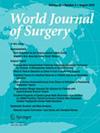A natural language processing-informed adrenal gland incidentaloma clinic improves guideline-based care.
IF 2.3
3区 医学
Q2 SURGERY
引用次数: 0
Abstract
INTRODUCTION Adrenal gland incidentalomas (AGIs) are found in up to 5% of cross-sectional images. However, rates of guideline-based workup for AGIs are notoriously low. We sought to determine if a natural language processing (NLP)-informed AGI clinic could improve the rates of indicated biochemical evaluation and adrenal-specific imaging. METHODS An NLP algorithm was created to detect clinically significant adrenal nodules from radiology reports of cross-sectional images at an academic institution. The NLP algorithm was applied to scans occurring between June 2020 and July 2021 to form a baseline cohort. The NLP algorithm was re-applied to scans from August 2021 to February 2023 and identified patients were invited to join an outpatient clinic dedicated to AGIs. Patients evaluated in the clinic from March 2022 to February 2023 were included in the intervention cohort. Statistical analysis utilized chi-square, t-test, and a multivariable logistic regression. RESULTS The baseline and intervention cohorts included 1784 and 322 unique patients, respectively. Patients in the intervention cohort were more likely to be female (59% vs. 51%, p = 0.01), be younger (60 ± 13.1 vs. 64 ± 13.2 years, p < 0.001), have smaller nodules (1.7 cm, IQR 1.4-2.1 vs. 1.8 cm, IQR 1.4-2.5 cm, p = 0.017), have had biochemical workup (99% vs. 13%, p < 0.001), and have had adrenal-specific imaging (40% vs. 11%, p < 0.001). In a multivariable analysis, intervention cohort patients were significantly more likely to have had biochemical workup (odds ratio ,OR 1209, confidence interval ,CI 434-5117, p < 0.001) and adrenal-specific imaging (OR 8.89, CI 6.42-12.4, p < 0.001). CONCLUSION The implementation of an NLP-informed AGI clinic was associated with a seven-fold increase in biochemical workup and a three-fold increase in adrenal-specific imaging in participating patients.以自然语言处理为基础的肾上腺偶发瘤诊所改善了基于指南的护理。
简介:肾上腺偶发瘤(AGI)在横断面图像中的发现率高达 5%。然而,基于指南的 AGI 检查率却很低。我们试图确定以自然语言处理(NLP)为基础的 AGI 诊所是否能提高指定生化评估和肾上腺特异性成像的比率。方法在一家学术机构中创建了一种 NLP 算法,用于从横断面图像的放射学报告中检测具有临床意义的肾上腺结节。NLP 算法适用于 2020 年 6 月至 2021 年 7 月期间进行的扫描,以形成基线队列。NLP 算法再次应用于 2021 年 8 月至 2023 年 2 月期间的扫描,并邀请确定的患者加入 AGI 专科门诊。2022 年 3 月至 2023 年 2 月在门诊接受评估的患者被纳入干预队列。统计分析采用了卡方检验、t 检验和多变量逻辑回归。结果基线队列和干预队列分别包括 1784 名和 322 名患者。干预队列中的患者更可能是女性(59% 对 51%,P = 0.01)、更年轻(60 ± 13.1 岁对 64 ± 13.2 岁,P < 0.001)、结节更小(1.7 cm,IQR 1.4-2.1 vs. 1.8 cm,IQR 1.4-2.5 cm,p = 0.017),做过生化检查(99% vs. 13%,p < 0.001),做过肾上腺特异性成像(40% vs. 11%,p < 0.001)。在一项多变量分析中,干预队列患者接受生化检查(几率比为 OR 1209,置信区间为 CI 434-5117,p < 0.001)和肾上腺特异性成像检查(OR 8.89,CI 6.42-12.4,p < 0.001)的可能性显著增加。
本文章由计算机程序翻译,如有差异,请以英文原文为准。
求助全文
约1分钟内获得全文
求助全文
来源期刊

World Journal of Surgery
医学-外科
CiteScore
5.10
自引率
3.80%
发文量
460
审稿时长
3 months
期刊介绍:
World Journal of Surgery is the official publication of the International Society of Surgery/Societe Internationale de Chirurgie (iss-sic.com). Under the editorship of Dr. Julie Ann Sosa, World Journal of Surgery provides an in-depth, international forum for the most authoritative information on major clinical problems in the fields of clinical and experimental surgery, surgical education, and socioeconomic aspects of surgical care. Contributions are reviewed and selected by a group of distinguished surgeons from across the world who make up the Editorial Board.
 求助内容:
求助内容: 应助结果提醒方式:
应助结果提醒方式:


